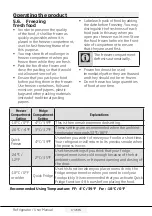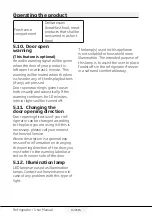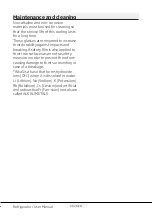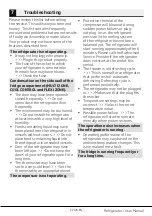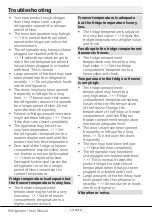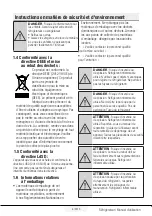
23/26 EN
Refrigerator / User Manual
Troubleshooting
•
Protective thermal of the
compressor will blow out during
sudden power failures or plug-
out plug-ins as the refrigerant
pressure in the cooling system
of the refrigerator has not been
balanced yet. The refrigerator will
start running approximately after 6
minutes. Please call the Authorised
Service Provider if the refrigerator
does not start at the end of this
period.
•
The freezer is in defrosting cycle.
>>>This is normal for a refrigerator
that performs full-automatic
defrosting. Defrosting cycle is
performed periodically.
•
The refrigerator may not be plugged
in. >>>Make sure that the plug fits
the socket.
•
Temperature settings may be
incorrect. >>>Select the correct
temperature value.
•
Possible power failure. >>>The
refrigerator will start to operate
normally when power restores.
The operation noise increases when
the refrigerator is running.
•
Operating performance of the
refrigerator may vary based on the
ambient temperature changes. This
is normal and not a fault.
The fridge is running frequently or
for a long time.
•
Your new product may be bigger
than the previous one. Larger
refrigerators operate for a longer
period of time.
•
The room temperature may be high.
>>> It is normal that the product
operates for longer periods in hot
environments.
•
The refrigerator may have just been
plugged in or loaded with food.
>>>It takes the product longer to
reach the set temperature when it
has just been plugged in or loaded
with food. This is normal.
•
Large amounts of hot food may have
been placed into the refrigerator
recently. >>>Do not place hot foods
into the refrigerator.
•
The doors may have been opened
frequently or left ajar for a long
time. >>>The warm air that enters
the refrigerator causes it to operate
for a longer period of time. Do not
open the doors frequently.
•
Freezer or fridge compartment door
may have been left ajar. >>> Check
if the doors are closed completely.
•
The appliance may be set to a
very low temperature. >>> Set
the refrigerator temperature to a
warmer degree and wait until the
product reaches this temperature.
•
Door seal of the fridge or freezer
compartment may be soiled, worn
out, broken or not properly seated.
>>> Clean or replace the seal.
Damaged/broken seal causes the
refrigerator to run for a longer
period of time to maintain the
current temperature.
Fridge temperature is adequate but
the freezer temperature is very low.
•
The freezer compartment
temperature may be set to a very
low value. >>> Set the freezer
compartment temperature to a
higher value and check.
Freezer temperature is adequate
but the fridge temperature is very
low.
•
The fridge temperature is adjusted
to a very low value. >>> Adjust the
fridge temperature to a higher value
and check.
Food kept in the fridge compartment
drawers is frozen.
•
The fridge compartment
temperature may be set to a very
high value. >>> Set the fridge
compartment temperature to a
lower value and check.
Temperature in the fridge or freezer
is very high.
•
The fridge compartment
temperature may be set to a
very high value. >>> Fridge
compartment temperature setting
has an effect on the temperature
of the freezer. Change the
temperature of the fridge or freezer
compartment until the fridge or
freezer compartment temperature
reaches an adequate level.
•
The doors may have been opened
frequently or left ajar for a long
time. >>>Do not open the doors
frequently.
•
The door may have been left ajar.
>>>Close the door completely.
•
The refrigerator may have been
just plugged in or loaded with food.
>>>This is normal. It takes the
product longer to reach the set
temperature when it has just been
plugged in or loaded with food.
•
Large amounts of hot food may have
been placed into the refrigerator
recently. >>>Do not place hot foods
into the refrigerator.
Vibration or noise.









